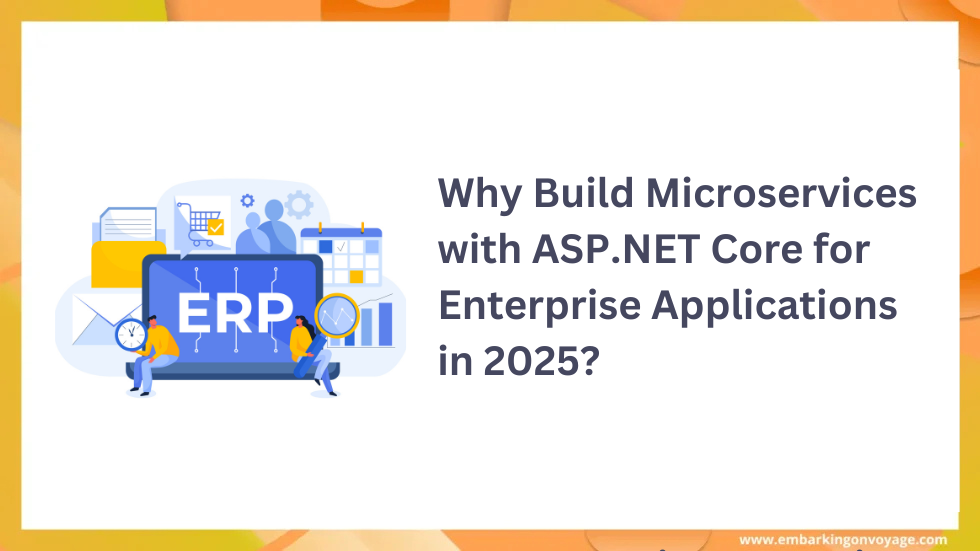In the modern digital landscape, software systems must be scalable, flexible, and resilient to meet growing business demands. Traditional monolithic applications—where the entire system is built as one unit—often fall short when it comes to agility and scaling.
This is where microservices with ASP.NET Core play a transformative role. By breaking applications into smaller, independent services, organizations gain the ability to innovate faster, scale efficiently, and adapt to changing requirements without disrupting the entire system.
In this blog, we’ll explore what microservices are, why they matter for enterprises and startups, and how you can build them using ASP.NET Core Web API with modern practices like containerization, service communication, and security.
What Are Microservices?
A microservices architecture is an approach where applications are designed as a collection of independent, loosely coupled services. Each service focuses on a specific business capability and can be developed, deployed, and scaled separately.
Benefits of Microservices with ASP.NET Core
- Scalability: Services can be scaled independently to optimize resources.
- Flexibility: Teams can use different technologies for different services.
- Resilience: If one service fails, it doesn’t bring down the entire application.
- Faster development cycles: Smaller services mean shorter release cycles.
- Easier maintenance: Smaller codebases simplify debugging and updates.
For enterprises and startups, these benefits translate into reduced time-to-market, improved agility, and long-term cost efficiency.
Building a Microservice with ASP.NET Core Web API
Let’s walk through building a simple Product Service that manages product data using ASP.NET Core Web API microservices development.
Step 1: Setting Up the Project
dotnet new webapi -n ProductService
cd ProductService
Step 2: Creating the Product Model
w// Models/Product.cs
public class Product {
public int Id { get; set; }
public string Name { get; set; }
public string Description { get; set; }
public decimal Price { get; set; }
}
Step 3: Adding a Repository (In-Memory Example)
// Data/ProductRepository.cs
public class ProductRepository {
private static List<Product> _products = new() {
new Product { Id = 1, Name = “Laptop”, Description = “High-performance laptop”, Price = 1200 },
new Product { Id = 2, Name = “Mouse”, Description = “Wireless mouse”, Price = 25 },
new Product { Id = 3, Name = “Keyboard”, Description = “Mechanical keyboard”, Price = 80 }
};
public List<Product> GetAllProducts() => _products;
public Product GetProductById(int id) => _products.FirstOrDefault(p => p.Id == id);
public void AddProduct(Product product) { product.Id = _products.Max(p => p.Id) + 1; _products.Add(product); }
public void UpdateProduct(Product product) { var existing = _products.FirstOrDefault(p => p.Id == product.Id); if (existing != null) { existing.Name = product.Name; existing.Description = product.Description; existing.Price = product.Price; } }
public void DeleteProduct(int id) { var product = _products.FirstOrDefault(p => p.Id == id); if (product != null) _products.Remove(product); }
}
Step 4: Building the Controller
// Controllers/ProductsController.cs
[ApiController]
[Route(“[controller]”)]
public class ProductsController : ControllerBase {
private readonly ProductRepository _repository;
public ProductsController(ProductRepository repository) => _repository = repository;
[HttpGet] public IActionResult Get() => Ok(_repository.GetAllProducts());
[HttpGet(“{id}”)] public IActionResult Get(int id) => _repository.GetProductById(id) is { } product ? Ok(product) : NotFound();
[HttpPost] public IActionResult Post([FromBody] Product product) { _repository.AddProduct(product); return CreatedAtAction(nameof(Get), new { id = product.Id }, product); }
[HttpPut(“{id}”)] public IActionResult Put(int id, [FromBody] Product product) { if (id != product.Id) return BadRequest(); _repository.UpdateProduct(product); return NoContent(); }
[HttpDelete(“{id}”)] public IActionResult Delete(int id) { _repository.DeleteProduct(id); return NoContent(); }
}
Finally, register the repository in Program.cs:
builder.Services.AddSingleton<ProductRepository>();
Communication Between Microservices
Microservices must interact seamlessly. Common communication methods include:
- HTTP/REST: Simple and widely adopted.
- Message Queues (RabbitMQ, Kafka): For asynchronous and decoupled workflows.
- gRPC: High-performance option for low-latency communication.
For example, an Order Service may call the Product Service to retrieve product details before finalizing an order.
Deploying Microservices with Docker and Kubernetes
Containerization ensures consistency across environments. With Docker, each microservice is packaged with its dependencies.
Sample Dockerfile for ProductService:
FROM mcr.microsoft.com/dotnet/sdk:6.0 AS build-env
WORKDIR /app
COPY *.csproj ./
RUN dotnet restore
COPY . ./
RUN dotnet publish -c Release -o out
FROM mcr.microsoft.com/dotnet/aspnet:6.0
WORKDIR /app
COPY –from=build-env /app/out .
ENTRYPOINT [“dotnet”, “ProductService.dll”]
For production, orchestration tools like Kubernetes or Docker Swarm manage scaling, service discovery, and load balancing.
Security in ASP.NET Core Microservices
Security is critical in a microservices architecture with ASP.NET Core. Best practices include:
- Authentication & Authorization: Implement JWT or OAuth 2.0.
- mTLS for service-to-service communication.
- API Gateway Security: Protect gateways with firewalls and rate-limiting.
- Data Encryption: Secure sensitive information both at rest and in transit.
Monitoring, Logging, and Testing
To ensure stability, enterprises should integrate:
- Monitoring tools: Prometheus, Grafana, or Application Insights.
- Logging solutions: ELK Stack (Elasticsearch, Logstash, Kibana).
- Testing approaches: Unit, integration, contract, and end-to-end testing.
Best Practices for Microservices with ASP.NET Core
- Align services with business domains (Domain-Driven Design).
- Follow Twelve-Factor App principles.
- Use an API-first approach.
- Implement circuit breakers for fault tolerance.
- Ensure idempotency for reliable retries.
Conclusion
Adopting microservices with ASP.NET Core empowers enterprises and startups to build applications that are scalable, resilient, and future-ready.
By leveraging containerization, secure communication, and industry best practices, organizations can transform their software systems into flexible platforms capable of adapting to modern business demands.
For companies looking to modernize legacy systems or launch new scalable platforms, ASP.NET Core microservices development offers the right balance of power, performance, and productivity.
Additional Resources:

